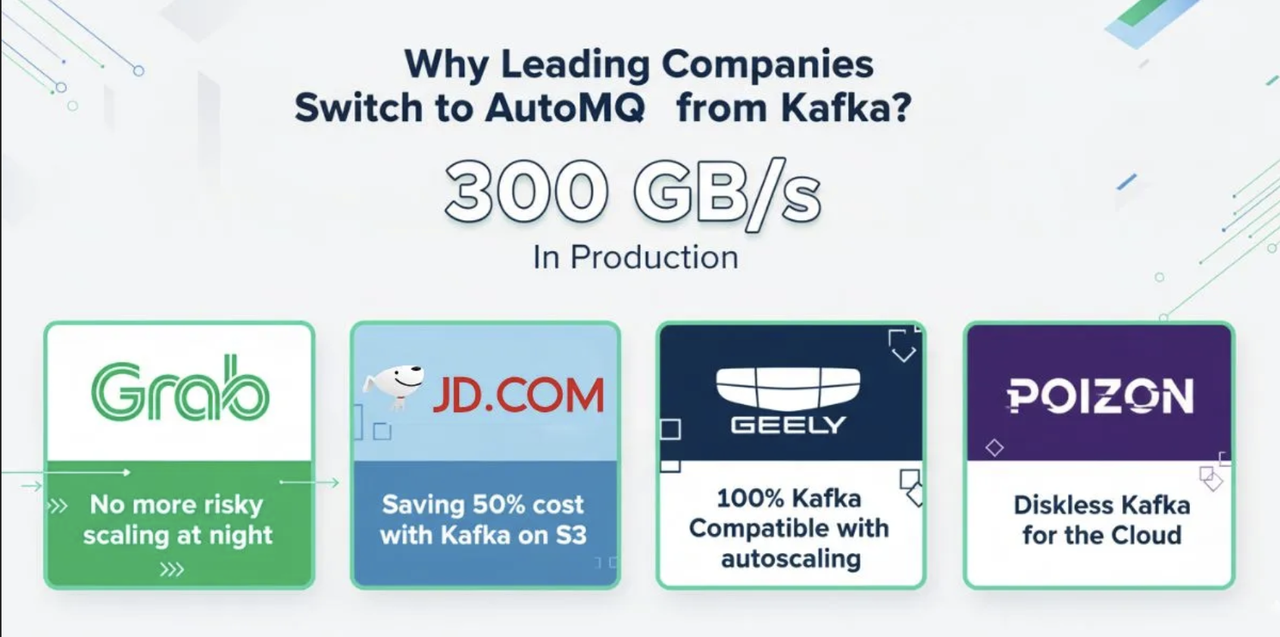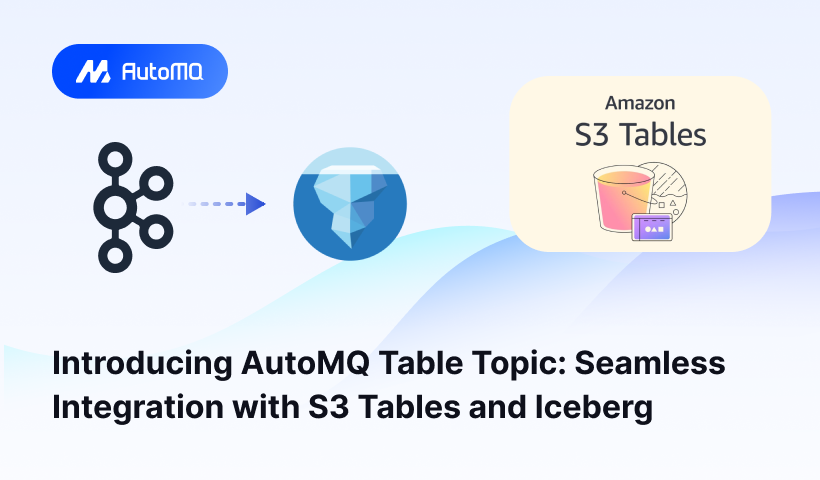The data streaming market is shifting fast. What once was a battle to build real-time pipelines has become a race to deliver speed, control, and cost predictability. By 2026, teams no longer ask “should we stream?”, they ask “how do we stream efficiently?”
In this new phase, Confluent Cloud and Redpanda stand at the center. Both promise Kafka-compatible performance, low latency, and easier management. Yet, their approaches couldn’t be more different. Confluent extends the original Kafka vision with a rich cloud platform and deep governance. Redpanda rebuilds Kafka’s core for modern infrastructure, chasing performance and simplicity.
The choice between them now shapes how businesses manage data scale, cloud costs, and developer velocity. This article breaks down how Confluent and Redpanda compare in 2026, cost, performance, ecosystem, and operations, and why many teams are beginning to look beyond both toward a new class of cloud-native streaming platforms like AutoMQ.
Key Takeaways
Confluent offers enterprise-grade reliability, deep governance, and rich ecosystem support, ideal for regulated or large-scale deployments.
Redpanda delivers lean performance, lower infrastructure cost, and developer freedom, suited for teams focused on speed and control.
Both still face cloud-era challenges: high cost, static scaling, and operational complexity.
AutoMQ bridges that gap. 100% Kafka-compatible, cloud-native, and elastic by design.
Market Context & the 2026 Streaming Landscape
In 2026, real-time data isn’t a differentiator; it’s infrastructure. Every business, from fintech to mobility, relies on streams to power decisions, automation, and AI. What has changed is how teams think about streaming: the priority has shifted from throughput to cost, elasticity, and autonomy.
The past two years saw streaming costs climb sharply on cloud-managed services. Teams running Confluent Cloud or self-managed Kafka learned that performance at scale comes with a price, in both compute and network usage. In response, new entrants like Redpanda redesigned Kafka’s architecture to eliminate dependencies and lower resource overhead.
At the same time, the market matured. Enterprises now demand:
Cloud-native efficiency: On-demand scaling without manual tuning.
Predictable cost models: To align with the modern FinOps discipline.
Operational simplicity: Minimal human intervention, full automation.
Ecosystem openness: Full Kafka compatibility to avoid lock-in.
Confluent and Redpanda evolved under these same pressures. Confluent leans into integration and AI streaming capabilities. Redpanda pursues raw performance and cost control. The result: two strong but distinct paths, one optimized for enterprise ecosystems, the other for developer autonomy.
Yet neither fully resolves the growing need for elastic, cloud-cost-optimized streaming, a gap now being filled by platforms purpose-built for the cloud era.
Confluent vs Redpanda: Head-to-Head Comparison
By 2026, both Confluent Cloud and Redpanda will offer Kafka-compatible streaming. Yet, they differ deeply in cost model, scalability, and ecosystem philosophy. Here’s how they compare where it matters most.
Cost and Total Cost of Ownership (TCO)
Confluent Cloud runs as a managed SaaS on major clouds. It charges per GB in/out plus compute. The platform has matured, but that also means a higher ongoing cost. Even with new optimizations like Private Network Interface (PNI) on AWS, which cuts cross-AZ costs by up to 50 % Confluent remains premium-priced.
Redpanda, built in C++, removes Java overhead and replication inefficiencies. Its benchmarks claim up to 6× lower cost than traditional Kafka deployments. The economics appeal to teams running large clusters or edge workloads.
However, cost transparency still depends on configuration. Redpanda’s savings assume optimized hardware and predictable load. Confluent’s managed service adds enterprise-grade SLAs and support.
Performance and Scalability
Redpanda’s architecture focuses on raw throughput and microsecond-level latency. Its 2024 update (v24.1) improved write caching and I/O paths, claiming 98 % lower latency on heavy workloads.
Confluent Cloud prioritizes consistency across regions and clouds. Its newer Streaming Agents integrate Apache Flink for in-stream processing, not always the fastest path, but built for complex pipelines.
In testing and reviews, Redpanda often wins on pure speed. Confluent wins when scalability must cross regions or include governance.
Verdict:
Choose Redpanda for maximum throughput at controlled scale.
Choose Confluent for multi-cloud reliability and governed expansion.
Operational Simplicity
Operating streaming at scale is still painful. Confluent Cloud reduces that pain through full management, provisioning, patching, and failover, all automated. The trade-off: less flexibility and a higher price.
Redpanda simplifies differently. Its binary deployment and absence of Zookeeper make it easy to run anywhere, even on edge clusters. But DevOps teams must still handle scaling, monitoring, and upgrades manually unless using Redpanda Cloud.
So, the 2026 reality:
Confluent → managed convenience, vendor control.
Redpanda → simpler codebase, more control, more responsibility.
Ecosystem, Compatibility, and Maturity
Confluent remains the ecosystem leader, with over 120 connectors, enterprise governance, Schema Registry, and Stream Catalog built in. It’s trusted by Fortune 500 users who value compliance and observability.
Redpanda matches Kafka’s APIs but offers a smaller plugin landscape. Its ecosystem is growing, especially with Kubernetes operators and OpenTelemetry integrations, yet it still trails Confluent’s maturity.
For teams with diverse data sources and compliance needs, Confluent’s ecosystem depth is decisive. For lean engineering orgs focused on performance over governance, Redpanda’s minimalism fits better.
Confluent vs Redpanda: Recent Developments and 2026 Implications
| Category | Confluent Cloud | Redpanda Streaming | 2026 Implications / Takeaway |
|---|---|---|---|
| Latest release & focus (as of 2025) | Q3 2025 launch introduced Streaming Agents (Flink-based, AI/event automation) and Private Network Interface (PNI) for AWS to cut network costs by ~20–50 %. (Confluent blog, Q3 2025) | Version 24.1 (May 2024) added write-caching and storage-path optimization for “98 % better latency”. (BigDataWire) | Both pivot toward AI-driven real-time use cases and performance/cost optimization. Expect stronger competition around AI and stream governance. |
| Cost Optimization Strategy | Network-cost reduction (PNI), streamlined consumption plans, and data tiering for long-term storage. Goal: improve cloud TCO for large Kafka deployments. | Claims up to 6× cheaper than “traditional Kafka” due to C++ implementation and no JVM overhead. Has a “price estimator” tool for planning. (redpanda.com) | Confluent targets large enterprises needing managed cloud services with gradual cost improvement; Redpanda positions as a leaner alternative for cost-sensitive or edge deployments. |
| Performance / Latency | Introduced new low-latency connectors and governance improvements for stream sharing and Flink integration. | Benchmarks show sub-ms latency in optimized configs; write-caching and Raft-based design focus on high throughput. | Redpanda likely retains a raw performance lead in simple pipelines; Confluent offers a stronger analytics and governance layer. |
| Ecosystem / Integrations | Mature Kafka ecosystem + >120 connectors + governance suite (Stream Catalog, Schema Registry, Stream Lineage). | Kafka-API compatible but smaller connector catalog; expanding K8s and OpenTelemetry integrations. | Enterprises with heavy connector use likely favor Confluent; developers building custom microservices may lean towards Redpanda. |
| AI / Streaming for 2026 | Investing heavily in event-driven AI integration (“streaming for AI”). Reports project 10× AI workload growth by 2026. (AInvest) | Marketing shift to “Agentic Data Plane & Streaming”, positioning for real-time AI agents. | Both vendors converge on AI/ML streaming; Confluent has an enterprise ecosystem advantage, Redpanda has a performance-edge story. |
| Operational Model / Ease of Use | Fully managed SaaS multi-cloud; governance and security controls for regulated orgs. | Simpler binary deployments for on-prem or edge clusters; lower ops burden but less enterprise tooling. | 2026 users will choose between control + simplicity (Redpanda) vs managed governance + support (Confluent). |
| Support / Lifecycle | Rolling updates and long-term support via Confluent Cloud SLA. | 12-month support policy per major release; faster release cadence. | Confluent emphasises stability; Redpanda prioritises feature velocity. |
| Pricing Model | Consumption-based (usage per GB in/out + compute). Discount tiers for enterprise agreements. | Predictable node-based enterprise license or SaaS subscription. | Confluent is more cloud-native scaling; Redpanda has more predictable CAPEX planning. |
Which One Is Right for Which Use Case
Choosing between Confluent and Redpanda in 2026 is about fit. Both solve the same problem, but they serve very different priorities.
When to Choose Confluent Cloud
Confluent fits organizations that treat streaming as part of a broader data ecosystem. It’s the right choice when you need:
Multi-cloud consistency: Unified deployment across AWS, Azure, and GCP.
Compliance and governance: With built-in Schema Registry, Stream Catalog, and audit controls.
Enterprise integration: Over a hundred pre-built connectors for SaaS, databases, and analytics platforms.
Zero-ops experience: Everything managed, monitored, and secured by Confluent Cloud.
For banks, large SaaS companies, and global retailers, Confluent’s managed service offsets higher cost with reliability and compliance. It suits teams that prefer predictability over control.
When to Choose Redpanda
Redpanda favors teams that build streaming as infrastructure, not as a managed service. It’s ideal for:
Cost-sensitive or edge workloads : Where efficiency matters more than managed SLAs.
Developer-driven teams: That want direct cluster control and performance tuning.
Low-latency systems: Fraud detection, IoT ingestion, and telemetry, where every millisecond counts.
Hybrid or on-prem setups: Needing simple deployment without the Kafka maintenance overhead.
Startups and mid-sized tech teams often pick Redpanda for agility and raw speed. It trades some ecosystem depth for performance and simplicity.
Why 2026 Might Be the Tipping Point for Alternatives
By 2026, streaming will have matured, but not simplified.
Confluent and Redpanda fixed many of Kafka’s early limits, yet two problems remain: cost and elasticity.
Cloud workloads fluctuate. Kafka-based systems still rely on static clusters and multi-replica storage, leading to waste when traffic drops. Confluent’s managed model makes scaling easy, but costs rise linearly. Redpanda offers efficiency, but scaling still needs manual work.
Teams now want cloud-native elasticity, streaming that scales instantly and only costs when used. They also want Kafka compatibility without lock-in or complexity.
That’s why 2026 marks a shift. Organizations are looking for platforms that deliver Kafka performance with true cloud efficiency. AutoMQ, built specifically to close the gaps both Confluent and Redpanda leave open.
Why AutoMQ Is Your Best Choice in 2026
Confluent and Redpanda each advanced the Kafka ecosystem. But in 2026, AutoMQ represents the next leap, a streaming platform built for the realities of cloud scale, unpredictable traffic, and cost efficiency.

Unlike others, AutoMQ didn’t just optimize Kafka. It reimagined it for the cloud era. By redesigning Kafka’s storage layer and separating computation from storage, AutoMQ eliminates the biggest source of waste in traditional clusters, idle, stateful brokers.
The result is a system that scales in seconds, not hours, and does so automatically. When workloads peak, AutoMQ expands instantly. When traffic slows, it contracts, cutting costs without human intervention. That’s why companies like XPENG Motors reduced streaming costs by over 50% after replacing Kafka with AutoMQ.
AutoMQ is also 100 % Kafka-compatible. Every Kafka API, tool, and connector works out of the box. Teams can migrate without rewriting a single line of code, no vendor lock-in, no forced rebuild.
But the value goes beyond technology. AutoMQ changes what data teams can expect from streaming:
Elastic by default: No partition rebalance downtime, no pre-allocated nodes.
Cost-predictable: Leverages cloud object storage (like S3) instead of expensive disks.
Operationally simple: No manual tuning, instant auto-scaling.
Freedom preserved: Open Kafka ecosystem compatibility with cloud-native economics.
AutoMQ brings the maturity of Kafka and the efficiency of serverless design together. For teams tired of paying for idle Kafka clusters or wrestling with scaling scripts, it offers a simpler truth: real-time streaming should be as dynamic as the workloads it supports.
In 2026, that makes AutoMQ the logical evolution of Kafka streaming.
Conclusion
By 2026, Confluent and Redpanda will have defined two strong paths for Kafka evolution, one built on managed stability, the other on speed and simplicity. Yet both still face limits in cost and elasticity. AutoMQ goes further: it keeps full Kafka compatibility while enabling instant scaling, lower cloud spend, and effortless operations. It turns streaming into a truly cloud-native service, flexible, efficient, and vendor-free.
Interested in our diskless Kafka solution, AutoMQ? See how leading companies leverage AutoMQ in their production environments by reading our case studies. The source code is also available on GitHub.
Grab: Driving Efficiency with AutoMQ in DataStreaming Platform
Palmpay Uses AutoMQ to Replace Kafka, Optimizing Costs by 50%+
How Asia’s Quora Zhihu uses AutoMQ to reduce Kafka cost and maintenance complexity
XPENG Motors Reduces Costs by 50%+ by Replacing Kafka with AutoMQ
Asia's GOAT, Poizon uses AutoMQ Kafka to build observability platform for massive data(30 GB/s)
AutoMQ Helps CaoCao Mobility Address Kafka Scalability During Holidays
JD.comx AutoMQ x CubeFS: A Cost-Effective Journey at Trillion-Scale Kafka Messaging
















.png)






